
The History of Sniper Elite III
Sniper Elite III takes place from June ‘til December of 1942, during the second half of the Western Desert Campaign in North Africa during World War II. Karl Fairburne has been sent as part of reinforcements and attached to the British offensive in the aftermath of Operation Crusader -- a massive Allied military push against Axis forces that secured the port city of Tobruk and led to the first major land victory over the Nazis.
The most interesting thing about Sniper Elite III is that Karl is not yet a special operative with special missions. As the game takes place before the events of V2 and 4, Karl is an established yet not-exactly-distinguished OSS sniper. That is reflected by the cutscene at the start of the prologue -- the only sequence in all Sniper Elite games to introduce Karl as he assembles his rifle instead of placing him smack dab in the middle of an infiltration.
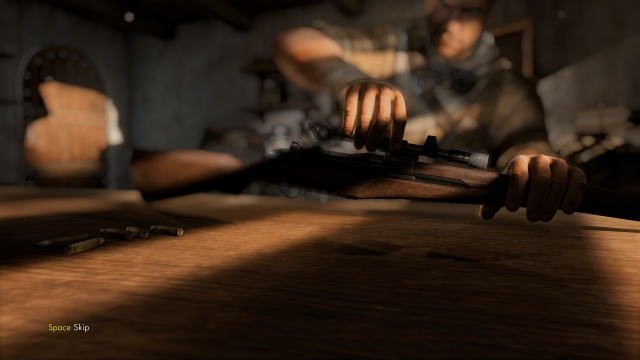
IKEA instructions not included.
When assigned to North Africa, he is sent to assist the war effort like virtually every other sharpshooter during the war. It’s only when his actions during the Battle of Gazala are recognised that he attracts the attention of the British Naval Intelligence and gets a special assignment. After that, Karl stops working as an army sniper and starts to act in conjunction with British Intelligence, eventually becoming an SOE operative.
The Battle of Gazala is the first mission of Sniper Elite III, wrongly referred in-game as the Siege of Tobruk. While Tobruk did fall under siege in June of 1942 and was lost to Axis forces, it was only encircled for a week; the brunt of that engagement actually took place in the neighboring village of Gazala for over 20 days, and that skirmish is therefore known as the Battle of Gazala.
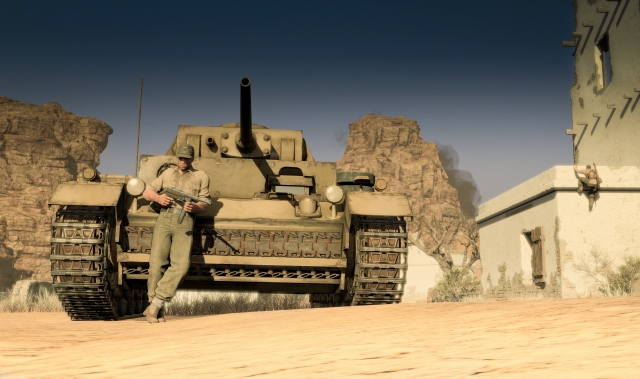
Captured for all eternity in this tasteful Facebook selfie of Hans and his Panzer tank.
The actual, historical Siege of Tobruk was a massive 241-days siege in 1941 (a year before Sniper Elite III begins), where Axis corps under the legendary Field Marshal Erwin Rommel encircled the port city of Tobruk in Libya and tried to take it from the British. Valiantly held for nine months, the Allies launched three subsequent offensives in the hopes of relieving Tobruk, until Operation Crusader finally managed to drive off the attacking Axis forces.
In the game, the Battle of Gazala is correctly depicted as taking place in a village located within an arid, mountainous region, but the village has some clear defensive fortifications around it, which present a problem. You see, the sea is nowhere in sight, but it would be in clear view if the battle had actually taken place at the fortress of Tobruk. Therefore, the wrongly named battle also wrongly places a fortress in the wrongly wrong place.
Rebellion isn't even American to try and justify this little mishap of geography.
As the mission begins, Karl is calmly assembling his M1C Garand sniper rifle -- which saw limited action in WWII and wasn’t even available during the North African campaign, since the Springfield M1903A4 was the standard sniper rifle at the time -- when the area comes under bombardment. Snipers are called to the front lines to eliminate the artillery spotters, and Karl rushes into the fray to shoot some people with binoculars in the head.
While the wrongly placed (and named) fortress is under attack, British personnel rush to the fortifications and start fighting back, while airplanes engage overhead. Karl kills all the artillery observers, but an Opel Blitz truck with a 2cm Flakvierling 38 Anti-Aircraft gun (which really existed) swings into view and starts blasting fighters out of the sky (which it really, really did). Fairburne then pulls the oldest trick in the Hollywood book: he shoots the fuel tank. The truck, of course, explodes -- but it shouldn’t. Sniper rounds are unable to deliver enough heat to ignite the contents of an ordinary fuel tank, and nothing short of a white phosphorus incendiary bullet is capable of even having a chance to cause a tank to go up in flames. Explosions are completely out of the question, then, since you need both heat, pressure, and an ungodly amount of compressed potential energy to cause a bang of that size. I won’t blame the game for blowing up a car with a shot to the fuel tank, but know this in your heart: Hollywood lies to you.
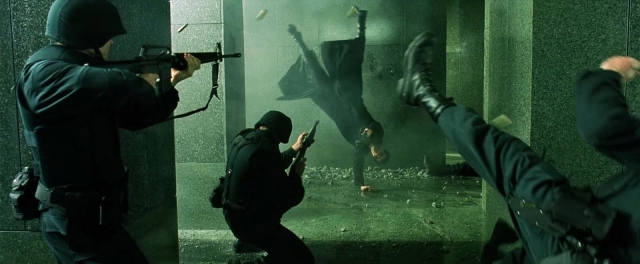
Believe it or not, real life firefights don't often develop like this.
The bombardment intensifies, and Karl almost gets killed -- a common occurrence for wartime snipers. He decides to get the hell out of Dodge and take out the damn artillery shelling the place, correctly identifying them by sound alone as Nebelwerfers, little mortar emplacements operated by a handful of soldiers each. Our titular sharpshooter goes behind enemy lines, take out the troops along with their nebelwerfers, and goes to check out how the battle is progressing from a nearby ridge. At which point, he sees Rommel’s Nazi tanks climb over a dune, overrun the defensive emplacements, and completely steamroll Tobruk.
It is interesting to note that although Tobruk had previously resisted a siege for nine months, it was no longer considered by those in charge as an essential location by this point. The strategic focus was wrongly placed on mounting a counter-offence, even though German Field Marshall Rommel was constantly pushing the line and had frequently defeated British forces in previous engagements. So when Tobruk fell, Karl’s initiative of going above and beyond the call of duty by venturing alone into enemy territory and single handedly taking out five mortars and dozens of Wehrmacht (German army) soldiers was noticed by British Naval Intelligence, and he was given a special assignment.
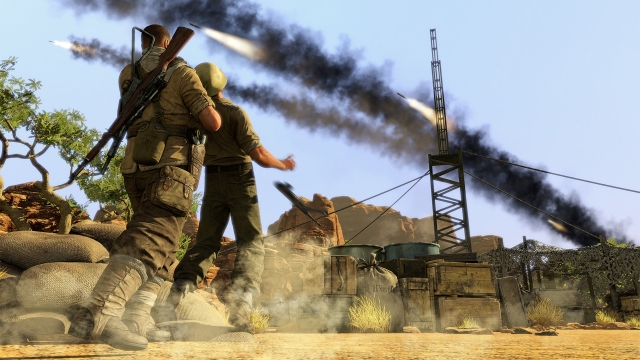
"Jolly good, old chap! You must now shoot and stab as many Nazis in the balls as you can!"
The NID (Naval Intelligence Division) was the intelligence arm of the British Admiralty War Staff, operating from 1912 to 1964, when it was replaced by the current and unified Defence Intelligence Staff. While not a separate branch like the MI6 (and SOE), it did run clandestine and commando operations. But unlike those other standalone branches, their operations tended to directly cooperate a lot more with the overall goal of the military forces, instead of just aiding the war effort in any way they could. As such, lore-wise, Karl Fairburne’s recruitment by the NID provided the perfect stepping stone for him to one day become an SOE operative and completely detach himself from parent units and military forces in later games.
The mission was to stop General Franz Vahlen, a fictional Nazi claimed to be a proponent of nerve agents in World War I. Biological weapons had not yet been banned under the Geneva Protocol back then, but it’s not like an evil Nazi general would care anyway, since Germany (and virtually every other bellic country) was still producing them way after the Protocol was signed in 1925. Karl accepted his new assignment and headed to the Gaberoun Oasis under cover of night in order to find any lead that would lead him to Vahlen.
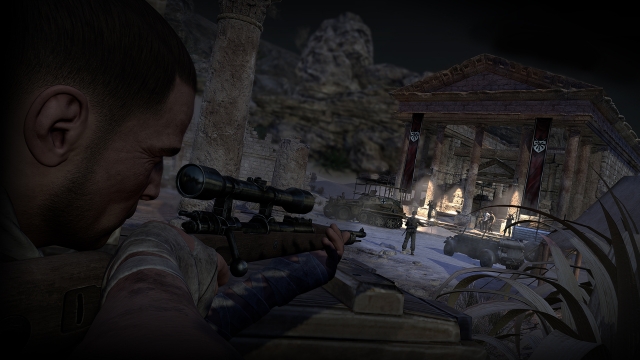
While shooting and stabbing as many Nazis in the balls as he could.
Described as an Axis transport hub, there was never any evidence that Gaberoun was used by any of the two sides as an outpost of any kind -- the only constructions there (besides tourist shops nowadays) are Beduin ruins and remnants of a relocated small tribe. In the game, there is a sizable Axis force stationed, complete with camps and motor pools -- while the layout and facilities in Gaberoun are historically correct and could have existed, it is doubtful they actually did. After clearing the Oasis and searching dead Nazi officers for clues, Karl’s only lead is a document revealing the project's name to be Seuche -- German for “Plague”. Fairburne returns that info to British Intelligence, which orders him to head to a Nazi PoW camp in the north and find an informant detained there who may provide further information.
Hitching a ride north with the Long Range Desert Group reconnaissance and raiding unit, Karl and the group face a conundrum when they must cross an escarpment full of people to be sniped and shit to be blown up. Knowing the Flak 88s stationed there can cut the whole battlegroup to pieces in seconds, they ask for Fairburne's assistance in sniping those people and blowing up that shit -- which he enthusiastically agrees to.
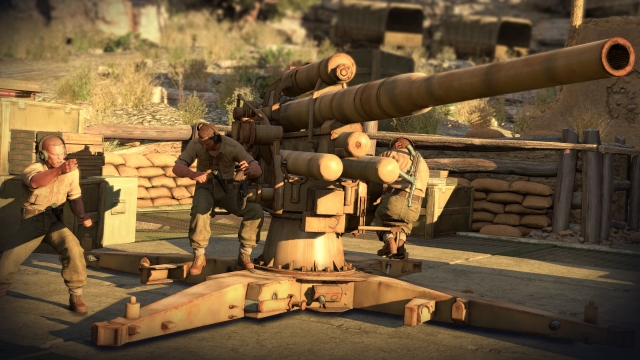
Karl hated these things with a passion.
The escarpment known as Halfaya Pass is a 200 meter high wall of rock located in Egypt, near the border with Libya. The pass had great strategic importance due to it being the only short route into the country from the east, and after Rommel's main force laid siege to Tobruk and occupied the pass in 1941, the Germans curtailed their advance due to supply shortages and dug in, fortifying their defensive positions with 88 millimetre anti-tank/anti-aircraft/anti-everything artillery guns -- those are the shit Karl is sent to destroy.
When Operation Battleaxe -- the predecessor of Operation Crusader -- was launched a year before this mission took place, the concealed 88mm guns cut down 11 out of 12 British tanks in a matter of minutes, earning the pass the nickname "Hellfire Pass". When Operation Crusader beat the Germans back and relieved Tobruk, the Pass was abandoned by Axis forces with nothing but a small Nazi garrison to hold it. Isolated, besieged, and bombarded from the air and the sea, the garrison surrendered to the British in January of 1942.
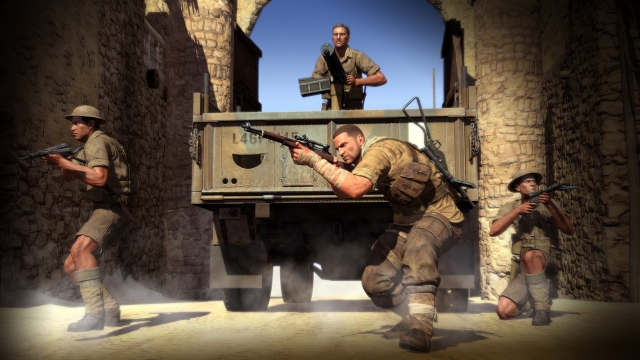
"FREEEEEEDOOOOM!" - Helldivers
If you been paying attention to the dates, you may have noticed that while the geographical location and Nazi emplacements are correct, the timeline is definitely not. That's because Karl's mission would have been completely feasible and realistic… if it had happened a year prior. By this time in 1942, Halfaya Pass had been under Allied control for over six months -- the African Campaign frontlines had moved on and the Pass didn't played any further role in the war after that. Karl’s ride through Hellfire Pass in late 1942 would have actually been a bumpy truck ride through a dusty canyon, not an adrenaline filled sniping session. Rebellion dropped the ball on this one.
Alas, Fairburne blows up the non-existent flak cannons, shoot the testicles off time-displaced Nazis, and takes out a tank too, because by this point, why not. The group moves through Halfaya Pass and the LRDG drop Karl off near Fort Rifugio -- where the informant is located -- and under the cover of darkness, our sniper elite sneaks through the fictional fort.
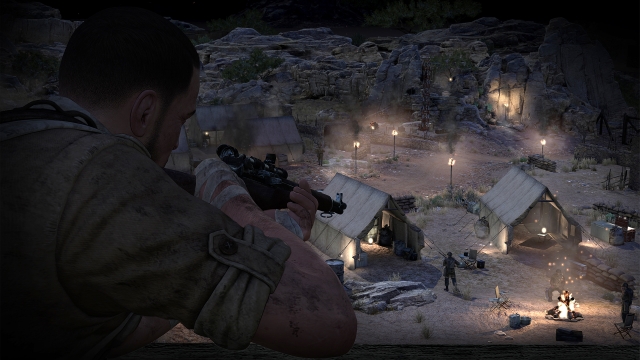
While shooting and stabbing as many Nazis in the ba... you got the drill.
The closest thing to a real Fort Rifugio was Fort Capuzzo, about 21km north-west of Halfaya Pass. Originally an Italian fortress built to repress the Libyan colony during the Second Italo-Senussi War (1923–1931), Fort Capuzzo was part of a series of forts called the “Frontier Wire”. Used to stop the Senussi resistance from moving freely across the border, the forts were similarly built and changed hands several times during the Western Desert Campaign. Given the timeline of the game, Fort Capuzzo seems to be the closest historical equivalent of Fort Rifugio -- it was the only fort under Axis control by late 1942, it was garrisoned by Germans, and it was close enough to the sea to mimic the game’s location. While Fort Rifugio is undoubtedly fictional, it wouldn’t be a stretch to place it somewhere on the Frontier Wire on an dramatized imaginary timeline.
After killing the whole fort and rescuing the PoW, Karl learns from him that a group of officers are meeting at the Siwa Oasis in Western Egypt. A real place, Siwa Oasis is a beautiful place and one of Egypt’s most isolated settlements, complete with an old town and fortress mostly abandoned nowadays. Originally the oracle of Ammon in the centuries before Christ, the oasis still exists mostly intact and even has a nearby population of 23,000 people nowadays. Back in World War II, no battles or garrisons took place in it, making it an ideal location for the meeting of three German officers conniving a betrayal against their General, like what happened in the game. Siwa Oasis is actually one of the best recreated maps in the whole of Sniper Elite III, capturing the tone, purpose, and view of the real world locale with exuberant talent.

Showcasing the value of setting games in new and unique environments.
Once there, Fairburne learns the officers plan to betray General Vahlen to Hitler by giving him the general's personal diary in Berlin, so our titular sniper kills them and steals the notebook. In it, he finds the location of Vahlen’s base of operations and his plans to conquer Europe once the Afrika Korps win in North Africa. Making haste to Kasserine Pass -- a real place between the Atlas Mountains in Central Tunisia where the US Army would suffer a devastating defeat in February of 1943 -- Karl infiltrates the General’s base of operations and learns from a secret movie reel that Project Seuche is actually a supertank codenamed Ratte.
Now, the Ratte was a piece of legend. A gigantic engineering beast weighing over 1000 tons and measuring 11 meters high by 39 long, the Landkreuzer P. 1000 Ratte, as his mother called him, was a prototypical super-heavy tank meant to crush any other armoured fighting vehicle in the world. Originally proposed by the head of German conglomerate Krupp, Edward Grotte, the Ratte sported a goddamn naval artillery cannon as its main weapon and quickly became a pet project of Hitler, who ordered it into production immediately after it was presented to him. In real life, the Ratte was never built -- it didn’t even leave the theoretical stage, since it’s massive weight would have collapsed bridges and destroyed roads. Instead, the project was under development from 1941 until 1943, when it was cancelled by Albert Speer, Reich Minister of Armaments and War Production for Nazi Germany. In the game, the tank timeline is slightly fabricated -- there is a working prototype in late 1942, while in real life, the tank was still being designed by December of the same year. And of course, there’s the small fact of there being a prototype, when in reality, none was ever built.
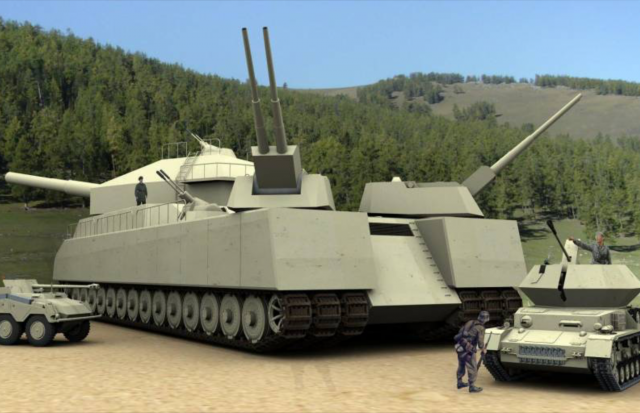
Which was fortunate for the Allies. Look at the size of that thing.
Alas, Karl leaves Kasserine Pass and once again hitches a ride with the LRDG and heads out to Pont Du Fahs Airfield, where there is a bunch of stuff in severe need of being blown up. Pont Du Fahs Airfield was a German-held airfield in Tunisia, from where the Luftwaffe (German air force) operated in North Africa. It was captured by British parachute infantry on 29 November 1942, and used by the U.S. Air Force until 1943. While the events depicted in the game do not exactly match, the timeline and the location do enough for it to be satisfactory.
In the Airfield, Karl finds a map leading to the Ratte Factory, which is located in the nearby Mides canyon. A beautiful mountain oasis in Tunisia, Mides canyon is home to an abandoned village and saw no action in the war. Needless to say, a prototype of the Ratte was never built here (or anywhere), and even if was built someplace, it definitely wouldn’t have been here -- it would have been built in continental Europe, most likely Germany, as that’s where all of the necessary facilities would have been located.
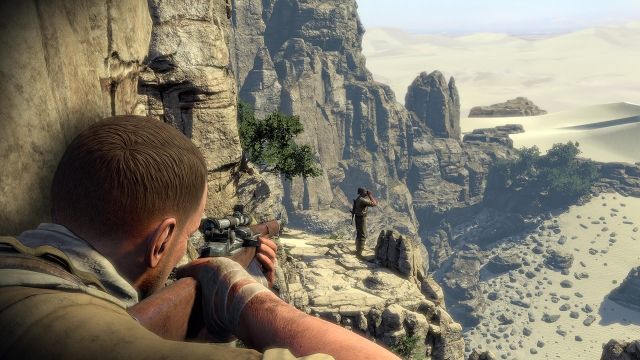
It may not be realistic, but at least it's damn pretty.
Karl heads to Mides Canyon, infiltrates the non-existent Ratte facility, destroys it along with the non-existent Ratter supertank, and shoots the non-existent General Vahlen in the head. He escapes the exploding factory, and reveals during the end credits that the intelligence he acquired on the Ratte enabled the USAAF and the RAF to launch the Battle of the Ruhr. Historically part of Operation Chastise, that battle was the 5-month long campaign of strategic bombing in 1943 that managed to completely halt Nazi increase in armaments’ production for a while, effectively slowing Hitler down and enabling the Allies to catch up. That was all true, although Karl’s role in the acquisition of intel for Operation Chastise is elementary fabricated.
Clearly, Sniper Elite was never meant to be taken seriously -- it is a game, so it is meant to be an entertaining experience first and foremost. It is incredible how even so, Rebellion managed to cram so much history and inspiration into it, heavily basing both the plot and the levels on historical facts and providing a much more meaningful and relevant progression than would have been achieved otherwise. Karl’s actions manage to perfectly walk the line between free and bombastic to be in a game, while being realistic enough to be of actual use to the war effort. This attention to detail and respect for the historical theme is why Sniper Elite thrives where so many other cookie-cutter World War II shooters failed -- it gets what made the World War II different, and it embraces it unlike any other.










COMMENTS